Analyzing Entrepreneurial Ventures in Public and Corporate Sectors
VerifiedAdded on 2020/12/18
|17
|3656
|260
Report
AI Summary
This report provides a comprehensive analysis of entrepreneurship and small business management, focusing on the classification of entrepreneurial ventures, including micro, small, medium, gazelle, large, private, public, and social enterprises. It explores the typologies of entrepreneurship, such as serial, scalable, male, female, intrapreneur, and owner-manager models. The report highlights the differences and similarities between various types of entrepreneurial ventures, particularly comparing micro, small, medium, and gazelle ventures, as well as public and private sector ventures. It also examines the impact of small businesses on the UK economy, considering factors such as turnover, employment, growth, and industry contributions. The analysis incorporates the role of both public and corporate sectors in fostering entrepreneurial activities and addresses the challenges faced by small businesses in achieving sustained growth.
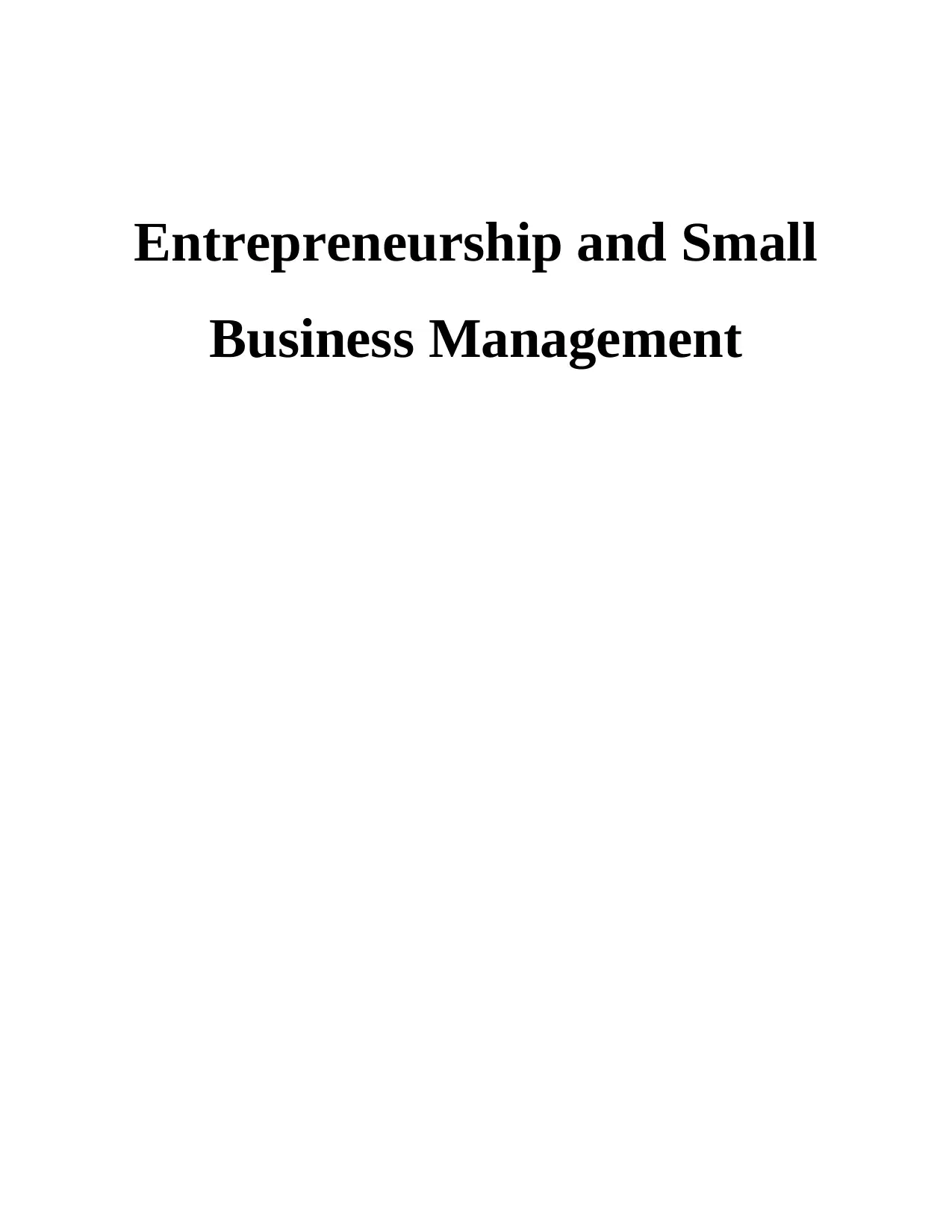
Entrepreneurship and Small
Business Management
Business Management
Paraphrase This Document
Need a fresh take? Get an instant paraphrase of this document with our AI Paraphraser

Table of Contents
INTRODUCTION...........................................................................................................................1
ASSESSMENT 1 ............................................................................................................................1
P 1 ..........................................................................................................................................1
P 2 ..........................................................................................................................................2
M 1..........................................................................................................................................3
P 3 ..........................................................................................................................................4
P 4 ..........................................................................................................................................6
M 2 .........................................................................................................................................7
CONCLUSION ...............................................................................................................................9
REFERENCES .............................................................................................................................10
INTRODUCTION...........................................................................................................................1
ASSESSMENT 1 ............................................................................................................................1
P 1 ..........................................................................................................................................1
P 2 ..........................................................................................................................................2
M 1..........................................................................................................................................3
P 3 ..........................................................................................................................................4
P 4 ..........................................................................................................................................6
M 2 .........................................................................................................................................7
CONCLUSION ...............................................................................................................................9
REFERENCES .............................................................................................................................10

⊘ This is a preview!⊘
Do you want full access?
Subscribe today to unlock all pages.

Trusted by 1+ million students worldwide
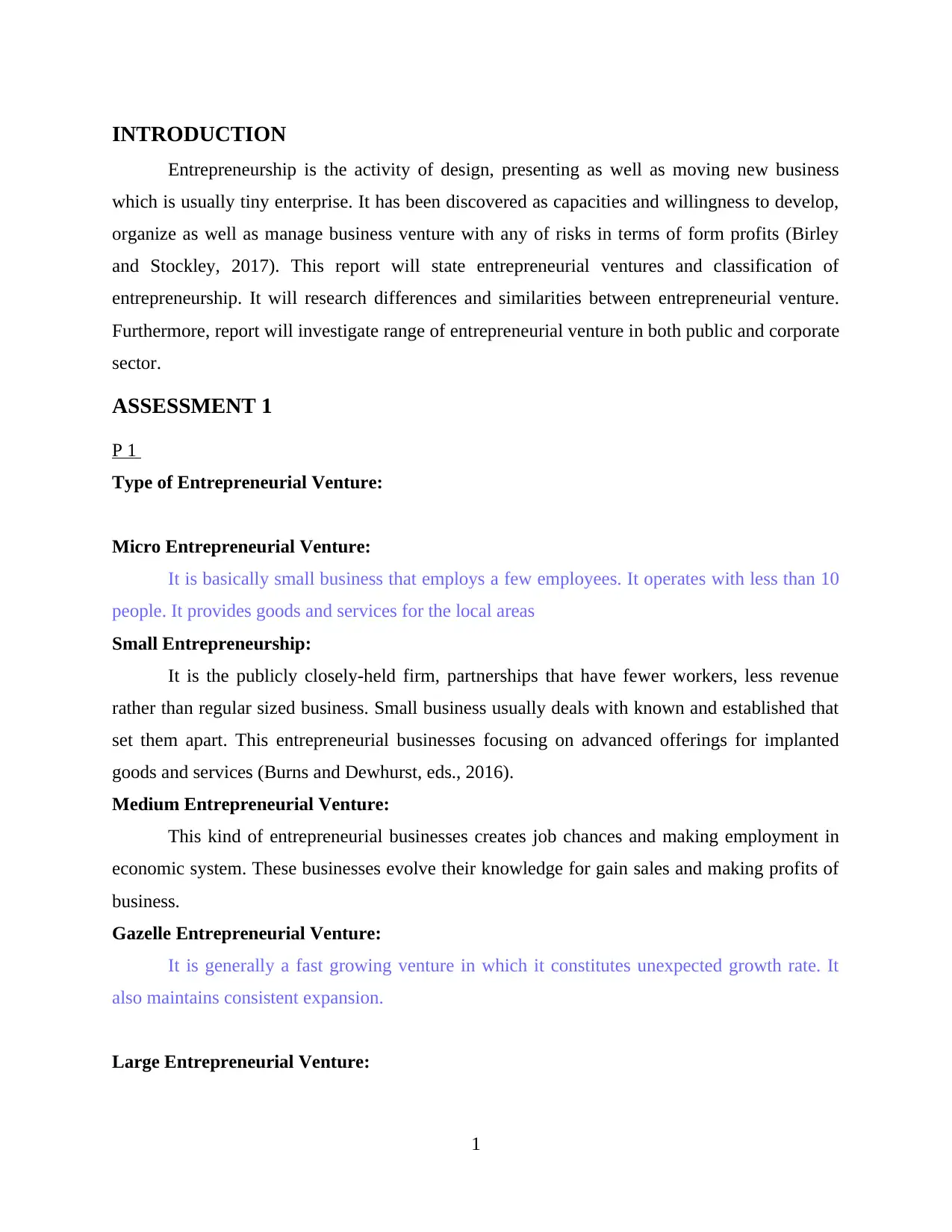
INTRODUCTION
Entrepreneurship is the activity of design, presenting as well as moving new business
which is usually tiny enterprise. It has been discovered as capacities and willingness to develop,
organize as well as manage business venture with any of risks in terms of form profits (Birley
and Stockley, 2017). This report will state entrepreneurial ventures and classification of
entrepreneurship. It will research differences and similarities between entrepreneurial venture.
Furthermore, report will investigate range of entrepreneurial venture in both public and corporate
sector.
ASSESSMENT 1
P 1
Type of Entrepreneurial Venture:
Micro Entrepreneurial Venture:
It is basically small business that employs a few employees. It operates with less than 10
people. It provides goods and services for the local areas
Small Entrepreneurship:
It is the publicly closely-held firm, partnerships that have fewer workers, less revenue
rather than regular sized business. Small business usually deals with known and established that
set them apart. This entrepreneurial businesses focusing on advanced offerings for implanted
goods and services (Burns and Dewhurst, eds., 2016).
Medium Entrepreneurial Venture:
This kind of entrepreneurial businesses creates job chances and making employment in
economic system. These businesses evolve their knowledge for gain sales and making profits of
business.
Gazelle Entrepreneurial Venture:
It is generally a fast growing venture in which it constitutes unexpected growth rate. It
also maintains consistent expansion.
Large Entrepreneurial Venture:
1
Entrepreneurship is the activity of design, presenting as well as moving new business
which is usually tiny enterprise. It has been discovered as capacities and willingness to develop,
organize as well as manage business venture with any of risks in terms of form profits (Birley
and Stockley, 2017). This report will state entrepreneurial ventures and classification of
entrepreneurship. It will research differences and similarities between entrepreneurial venture.
Furthermore, report will investigate range of entrepreneurial venture in both public and corporate
sector.
ASSESSMENT 1
P 1
Type of Entrepreneurial Venture:
Micro Entrepreneurial Venture:
It is basically small business that employs a few employees. It operates with less than 10
people. It provides goods and services for the local areas
Small Entrepreneurship:
It is the publicly closely-held firm, partnerships that have fewer workers, less revenue
rather than regular sized business. Small business usually deals with known and established that
set them apart. This entrepreneurial businesses focusing on advanced offerings for implanted
goods and services (Burns and Dewhurst, eds., 2016).
Medium Entrepreneurial Venture:
This kind of entrepreneurial businesses creates job chances and making employment in
economic system. These businesses evolve their knowledge for gain sales and making profits of
business.
Gazelle Entrepreneurial Venture:
It is generally a fast growing venture in which it constitutes unexpected growth rate. It
also maintains consistent expansion.
Large Entrepreneurial Venture:
1
Paraphrase This Document
Need a fresh take? Get an instant paraphrase of this document with our AI Paraphraser
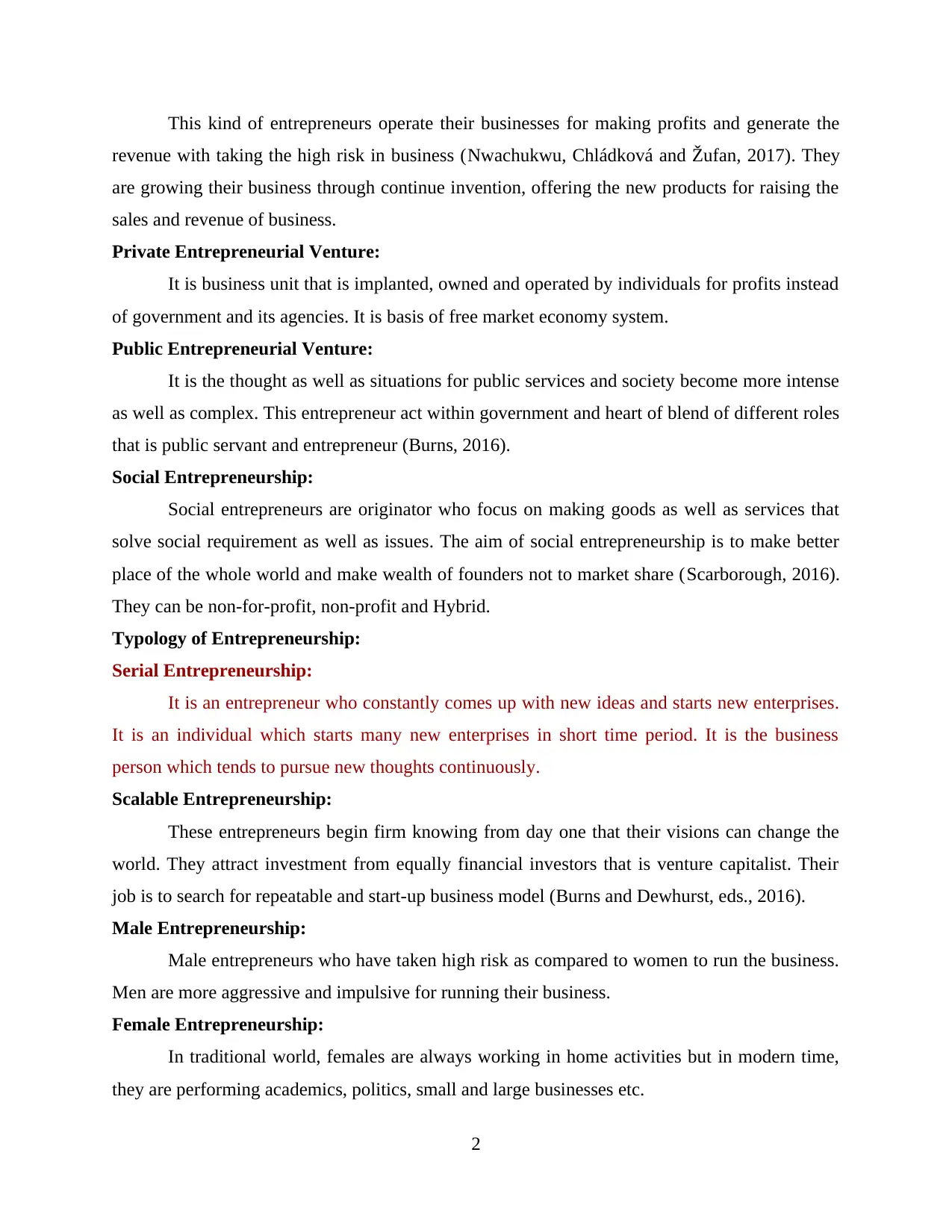
This kind of entrepreneurs operate their businesses for making profits and generate the
revenue with taking the high risk in business (Nwachukwu, Chládková and Žufan, 2017). They
are growing their business through continue invention, offering the new products for raising the
sales and revenue of business.
Private Entrepreneurial Venture:
It is business unit that is implanted, owned and operated by individuals for profits instead
of government and its agencies. It is basis of free market economy system.
Public Entrepreneurial Venture:
It is the thought as well as situations for public services and society become more intense
as well as complex. This entrepreneur act within government and heart of blend of different roles
that is public servant and entrepreneur (Burns, 2016).
Social Entrepreneurship:
Social entrepreneurs are originator who focus on making goods as well as services that
solve social requirement as well as issues. The aim of social entrepreneurship is to make better
place of the whole world and make wealth of founders not to market share (Scarborough, 2016).
They can be non-for-profit, non-profit and Hybrid.
Typology of Entrepreneurship:
Serial Entrepreneurship:
It is an entrepreneur who constantly comes up with new ideas and starts new enterprises.
It is an individual which starts many new enterprises in short time period. It is the business
person which tends to pursue new thoughts continuously.
Scalable Entrepreneurship:
These entrepreneurs begin firm knowing from day one that their visions can change the
world. They attract investment from equally financial investors that is venture capitalist. Their
job is to search for repeatable and start-up business model (Burns and Dewhurst, eds., 2016).
Male Entrepreneurship:
Male entrepreneurs who have taken high risk as compared to women to run the business.
Men are more aggressive and impulsive for running their business.
Female Entrepreneurship:
In traditional world, females are always working in home activities but in modern time,
they are performing academics, politics, small and large businesses etc.
2
revenue with taking the high risk in business (Nwachukwu, Chládková and Žufan, 2017). They
are growing their business through continue invention, offering the new products for raising the
sales and revenue of business.
Private Entrepreneurial Venture:
It is business unit that is implanted, owned and operated by individuals for profits instead
of government and its agencies. It is basis of free market economy system.
Public Entrepreneurial Venture:
It is the thought as well as situations for public services and society become more intense
as well as complex. This entrepreneur act within government and heart of blend of different roles
that is public servant and entrepreneur (Burns, 2016).
Social Entrepreneurship:
Social entrepreneurs are originator who focus on making goods as well as services that
solve social requirement as well as issues. The aim of social entrepreneurship is to make better
place of the whole world and make wealth of founders not to market share (Scarborough, 2016).
They can be non-for-profit, non-profit and Hybrid.
Typology of Entrepreneurship:
Serial Entrepreneurship:
It is an entrepreneur who constantly comes up with new ideas and starts new enterprises.
It is an individual which starts many new enterprises in short time period. It is the business
person which tends to pursue new thoughts continuously.
Scalable Entrepreneurship:
These entrepreneurs begin firm knowing from day one that their visions can change the
world. They attract investment from equally financial investors that is venture capitalist. Their
job is to search for repeatable and start-up business model (Burns and Dewhurst, eds., 2016).
Male Entrepreneurship:
Male entrepreneurs who have taken high risk as compared to women to run the business.
Men are more aggressive and impulsive for running their business.
Female Entrepreneurship:
In traditional world, females are always working in home activities but in modern time,
they are performing academics, politics, small and large businesses etc.
2
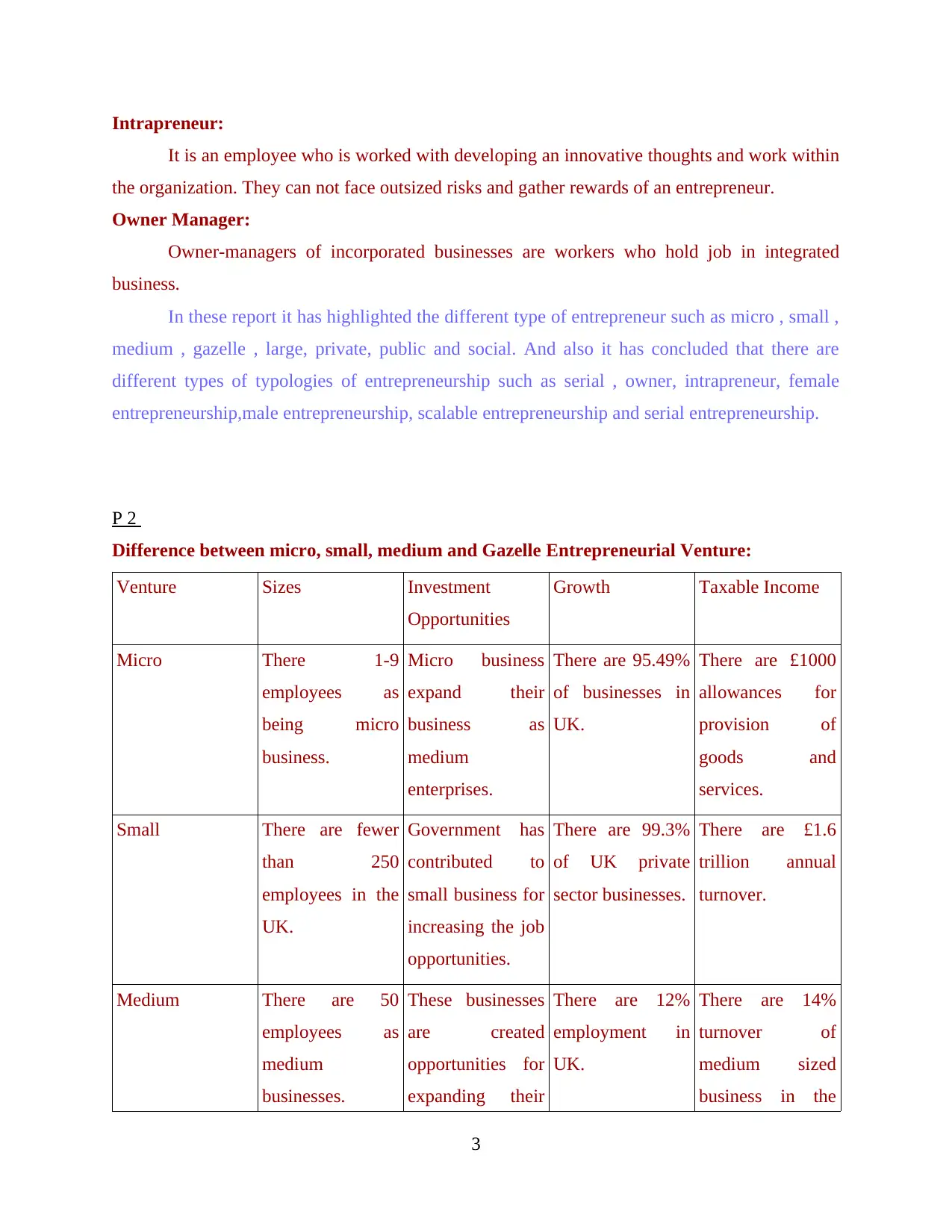
Intrapreneur:
It is an employee who is worked with developing an innovative thoughts and work within
the organization. They can not face outsized risks and gather rewards of an entrepreneur.
Owner Manager:
Owner-managers of incorporated businesses are workers who hold job in integrated
business.
In these report it has highlighted the different type of entrepreneur such as micro , small ,
medium , gazelle , large, private, public and social. And also it has concluded that there are
different types of typologies of entrepreneurship such as serial , owner, intrapreneur, female
entrepreneurship,male entrepreneurship, scalable entrepreneurship and serial entrepreneurship.
P 2
Difference between micro, small, medium and Gazelle Entrepreneurial Venture:
Venture Sizes Investment
Opportunities
Growth Taxable Income
Micro There 1-9
employees as
being micro
business.
Micro business
expand their
business as
medium
enterprises.
There are 95.49%
of businesses in
UK.
There are £1000
allowances for
provision of
goods and
services.
Small There are fewer
than 250
employees in the
UK.
Government has
contributed to
small business for
increasing the job
opportunities.
There are 99.3%
of UK private
sector businesses.
There are £1.6
trillion annual
turnover.
Medium There are 50
employees as
medium
businesses.
These businesses
are created
opportunities for
expanding their
There are 12%
employment in
UK.
There are 14%
turnover of
medium sized
business in the
3
It is an employee who is worked with developing an innovative thoughts and work within
the organization. They can not face outsized risks and gather rewards of an entrepreneur.
Owner Manager:
Owner-managers of incorporated businesses are workers who hold job in integrated
business.
In these report it has highlighted the different type of entrepreneur such as micro , small ,
medium , gazelle , large, private, public and social. And also it has concluded that there are
different types of typologies of entrepreneurship such as serial , owner, intrapreneur, female
entrepreneurship,male entrepreneurship, scalable entrepreneurship and serial entrepreneurship.
P 2
Difference between micro, small, medium and Gazelle Entrepreneurial Venture:
Venture Sizes Investment
Opportunities
Growth Taxable Income
Micro There 1-9
employees as
being micro
business.
Micro business
expand their
business as
medium
enterprises.
There are 95.49%
of businesses in
UK.
There are £1000
allowances for
provision of
goods and
services.
Small There are fewer
than 250
employees in the
UK.
Government has
contributed to
small business for
increasing the job
opportunities.
There are 99.3%
of UK private
sector businesses.
There are £1.6
trillion annual
turnover.
Medium There are 50
employees as
medium
businesses.
These businesses
are created
opportunities for
expanding their
There are 12%
employment in
UK.
There are 14%
turnover of
medium sized
business in the
3
⊘ This is a preview!⊘
Do you want full access?
Subscribe today to unlock all pages.

Trusted by 1+ million students worldwide
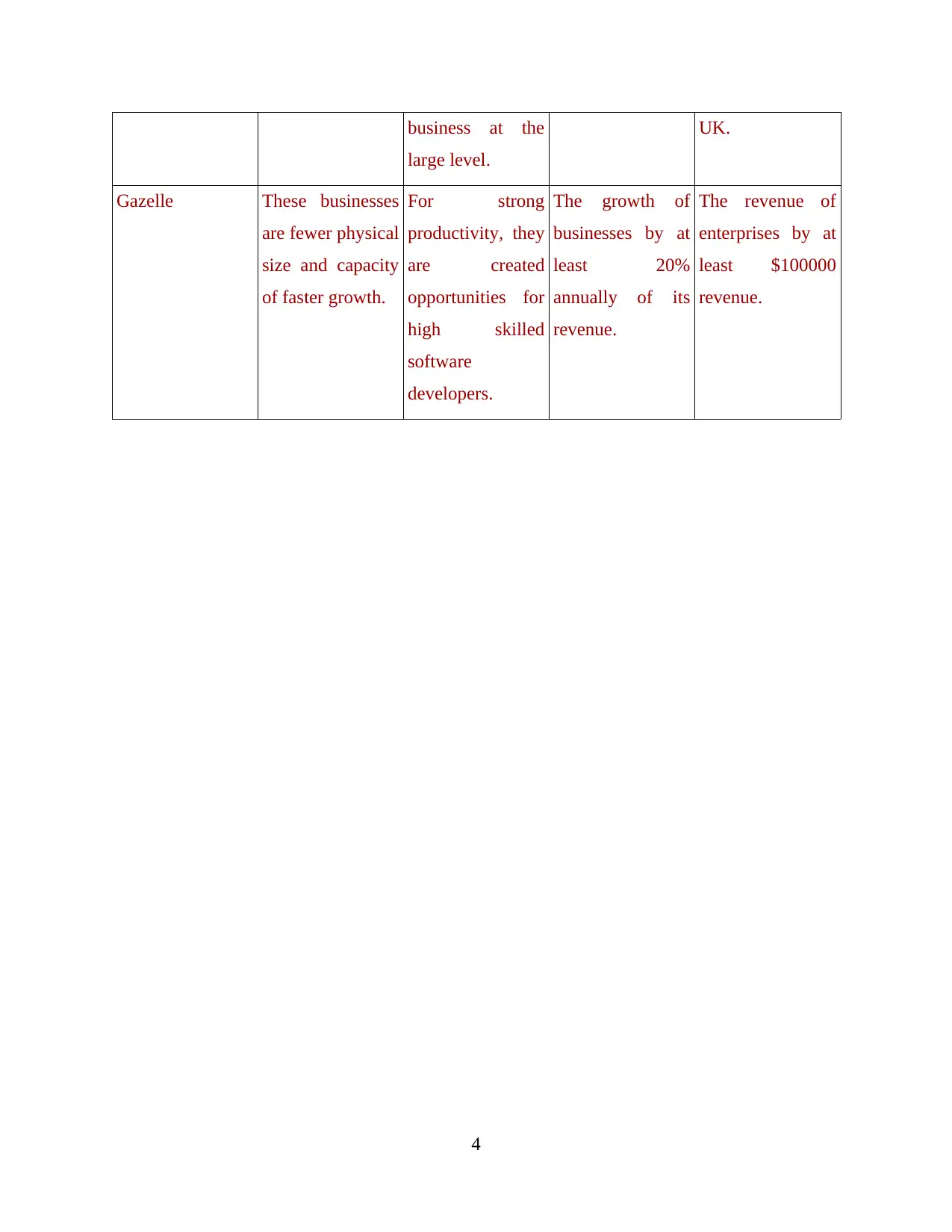
business at the
large level.
UK.
Gazelle These businesses
are fewer physical
size and capacity
of faster growth.
For strong
productivity, they
are created
opportunities for
high skilled
software
developers.
The growth of
businesses by at
least 20%
annually of its
revenue.
The revenue of
enterprises by at
least $100000
revenue.
4
large level.
UK.
Gazelle These businesses
are fewer physical
size and capacity
of faster growth.
For strong
productivity, they
are created
opportunities for
high skilled
software
developers.
The growth of
businesses by at
least 20%
annually of its
revenue.
The revenue of
enterprises by at
least $100000
revenue.
4
Paraphrase This Document
Need a fresh take? Get an instant paraphrase of this document with our AI Paraphraser
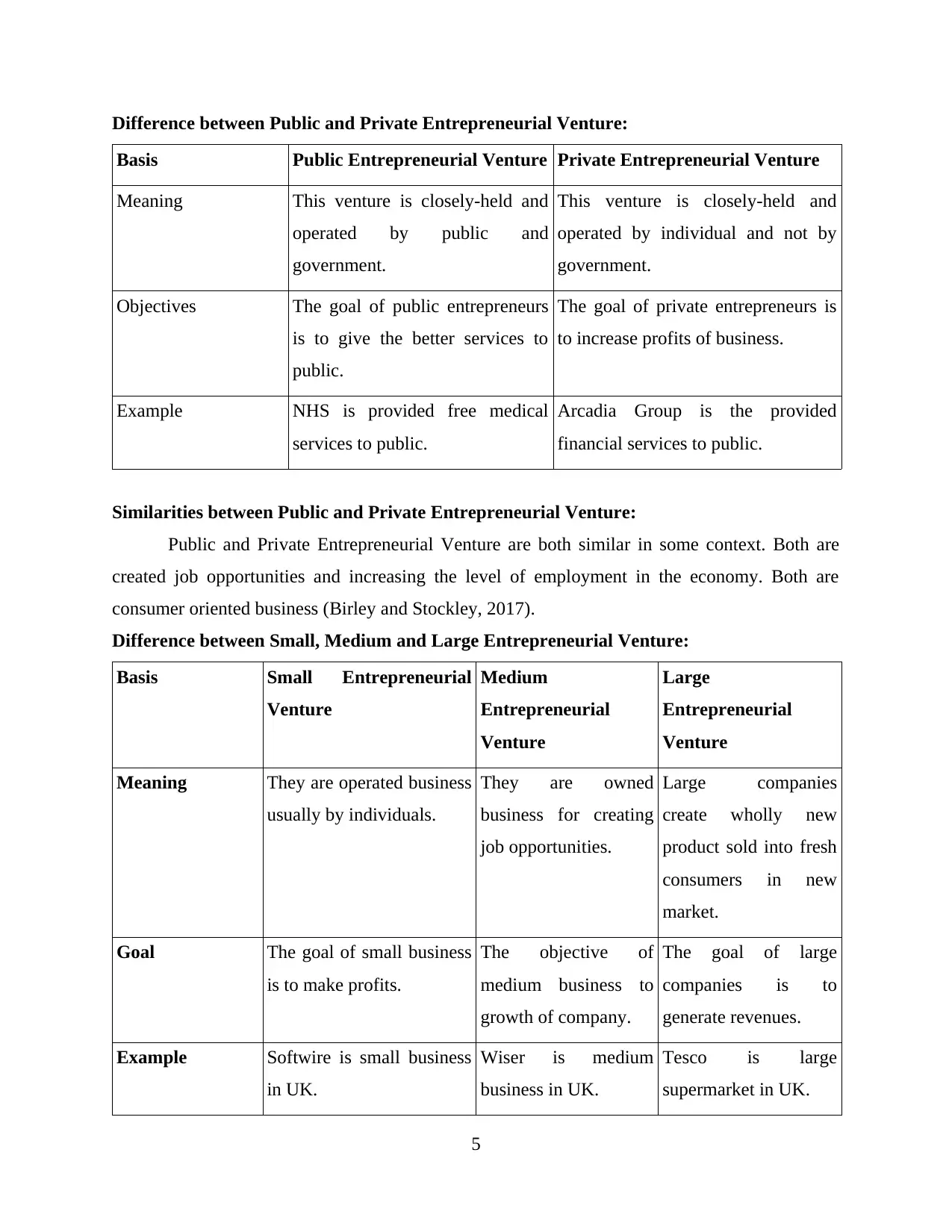
Difference between Public and Private Entrepreneurial Venture:
Basis Public Entrepreneurial Venture Private Entrepreneurial Venture
Meaning This venture is closely-held and
operated by public and
government.
This venture is closely-held and
operated by individual and not by
government.
Objectives The goal of public entrepreneurs
is to give the better services to
public.
The goal of private entrepreneurs is
to increase profits of business.
Example NHS is provided free medical
services to public.
Arcadia Group is the provided
financial services to public.
Similarities between Public and Private Entrepreneurial Venture:
Public and Private Entrepreneurial Venture are both similar in some context. Both are
created job opportunities and increasing the level of employment in the economy. Both are
consumer oriented business (Birley and Stockley, 2017).
Difference between Small, Medium and Large Entrepreneurial Venture:
Basis Small Entrepreneurial
Venture
Medium
Entrepreneurial
Venture
Large
Entrepreneurial
Venture
Meaning They are operated business
usually by individuals.
They are owned
business for creating
job opportunities.
Large companies
create wholly new
product sold into fresh
consumers in new
market.
Goal The goal of small business
is to make profits.
The objective of
medium business to
growth of company.
The goal of large
companies is to
generate revenues.
Example Softwire is small business
in UK.
Wiser is medium
business in UK.
Tesco is large
supermarket in UK.
5
Basis Public Entrepreneurial Venture Private Entrepreneurial Venture
Meaning This venture is closely-held and
operated by public and
government.
This venture is closely-held and
operated by individual and not by
government.
Objectives The goal of public entrepreneurs
is to give the better services to
public.
The goal of private entrepreneurs is
to increase profits of business.
Example NHS is provided free medical
services to public.
Arcadia Group is the provided
financial services to public.
Similarities between Public and Private Entrepreneurial Venture:
Public and Private Entrepreneurial Venture are both similar in some context. Both are
created job opportunities and increasing the level of employment in the economy. Both are
consumer oriented business (Birley and Stockley, 2017).
Difference between Small, Medium and Large Entrepreneurial Venture:
Basis Small Entrepreneurial
Venture
Medium
Entrepreneurial
Venture
Large
Entrepreneurial
Venture
Meaning They are operated business
usually by individuals.
They are owned
business for creating
job opportunities.
Large companies
create wholly new
product sold into fresh
consumers in new
market.
Goal The goal of small business
is to make profits.
The objective of
medium business to
growth of company.
The goal of large
companies is to
generate revenues.
Example Softwire is small business
in UK.
Wiser is medium
business in UK.
Tesco is large
supermarket in UK.
5
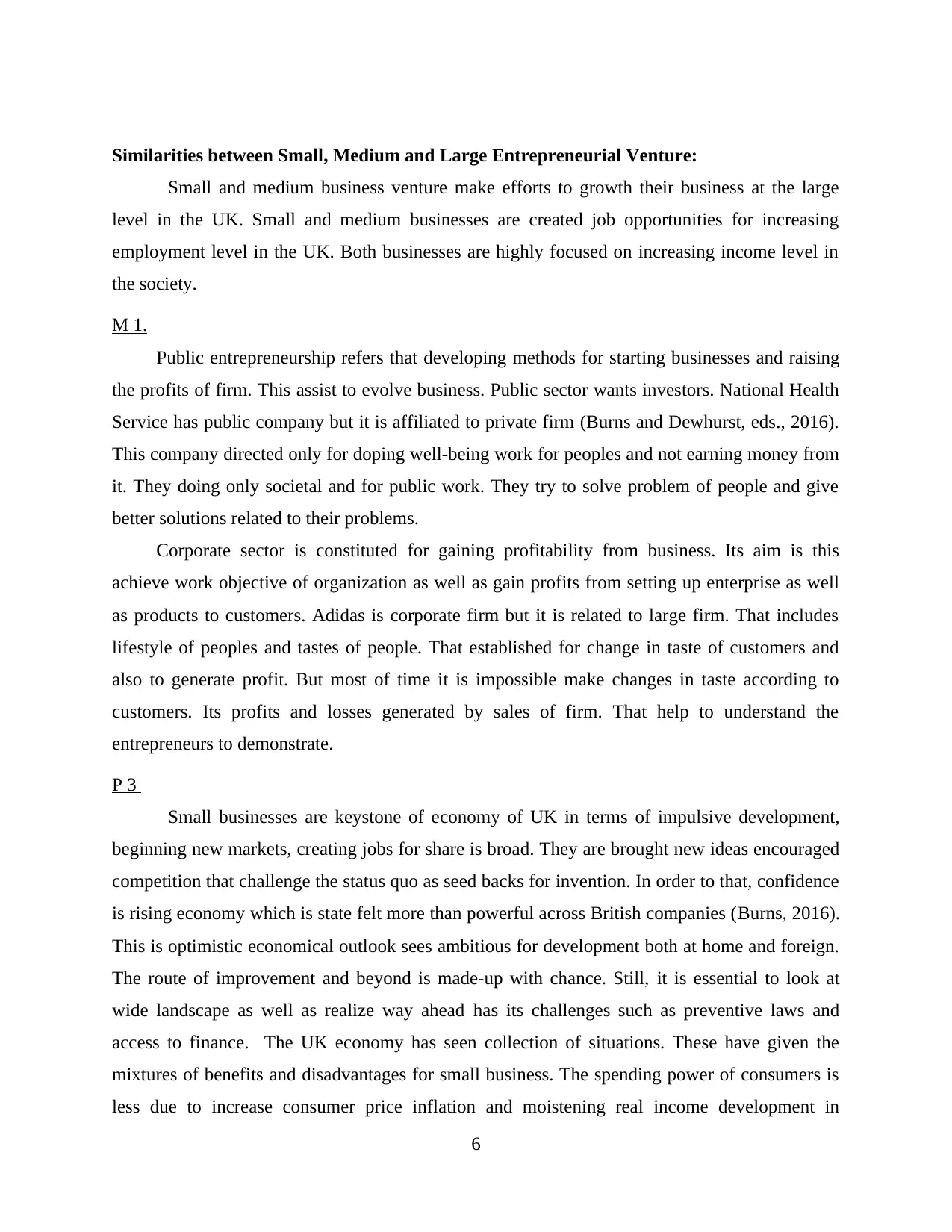
Similarities between Small, Medium and Large Entrepreneurial Venture:
Small and medium business venture make efforts to growth their business at the large
level in the UK. Small and medium businesses are created job opportunities for increasing
employment level in the UK. Both businesses are highly focused on increasing income level in
the society.
M 1.
Public entrepreneurship refers that developing methods for starting businesses and raising
the profits of firm. This assist to evolve business. Public sector wants investors. National Health
Service has public company but it is affiliated to private firm (Burns and Dewhurst, eds., 2016).
This company directed only for doping well-being work for peoples and not earning money from
it. They doing only societal and for public work. They try to solve problem of people and give
better solutions related to their problems.
Corporate sector is constituted for gaining profitability from business. Its aim is this
achieve work objective of organization as well as gain profits from setting up enterprise as well
as products to customers. Adidas is corporate firm but it is related to large firm. That includes
lifestyle of peoples and tastes of people. That established for change in taste of customers and
also to generate profit. But most of time it is impossible make changes in taste according to
customers. Its profits and losses generated by sales of firm. That help to understand the
entrepreneurs to demonstrate.
P 3
Small businesses are keystone of economy of UK in terms of impulsive development,
beginning new markets, creating jobs for share is broad. They are brought new ideas encouraged
competition that challenge the status quo as seed backs for invention. In order to that, confidence
is rising economy which is state felt more than powerful across British companies (Burns, 2016).
This is optimistic economical outlook sees ambitious for development both at home and foreign.
The route of improvement and beyond is made-up with chance. Still, it is essential to look at
wide landscape as well as realize way ahead has its challenges such as preventive laws and
access to finance. The UK economy has seen collection of situations. These have given the
mixtures of benefits and disadvantages for small business. The spending power of consumers is
less due to increase consumer price inflation and moistening real income development in
6
Small and medium business venture make efforts to growth their business at the large
level in the UK. Small and medium businesses are created job opportunities for increasing
employment level in the UK. Both businesses are highly focused on increasing income level in
the society.
M 1.
Public entrepreneurship refers that developing methods for starting businesses and raising
the profits of firm. This assist to evolve business. Public sector wants investors. National Health
Service has public company but it is affiliated to private firm (Burns and Dewhurst, eds., 2016).
This company directed only for doping well-being work for peoples and not earning money from
it. They doing only societal and for public work. They try to solve problem of people and give
better solutions related to their problems.
Corporate sector is constituted for gaining profitability from business. Its aim is this
achieve work objective of organization as well as gain profits from setting up enterprise as well
as products to customers. Adidas is corporate firm but it is related to large firm. That includes
lifestyle of peoples and tastes of people. That established for change in taste of customers and
also to generate profit. But most of time it is impossible make changes in taste according to
customers. Its profits and losses generated by sales of firm. That help to understand the
entrepreneurs to demonstrate.
P 3
Small businesses are keystone of economy of UK in terms of impulsive development,
beginning new markets, creating jobs for share is broad. They are brought new ideas encouraged
competition that challenge the status quo as seed backs for invention. In order to that, confidence
is rising economy which is state felt more than powerful across British companies (Burns, 2016).
This is optimistic economical outlook sees ambitious for development both at home and foreign.
The route of improvement and beyond is made-up with chance. Still, it is essential to look at
wide landscape as well as realize way ahead has its challenges such as preventive laws and
access to finance. The UK economy has seen collection of situations. These have given the
mixtures of benefits and disadvantages for small business. The spending power of consumers is
less due to increase consumer price inflation and moistening real income development in
6
⊘ This is a preview!⊘
Do you want full access?
Subscribe today to unlock all pages.

Trusted by 1+ million students worldwide
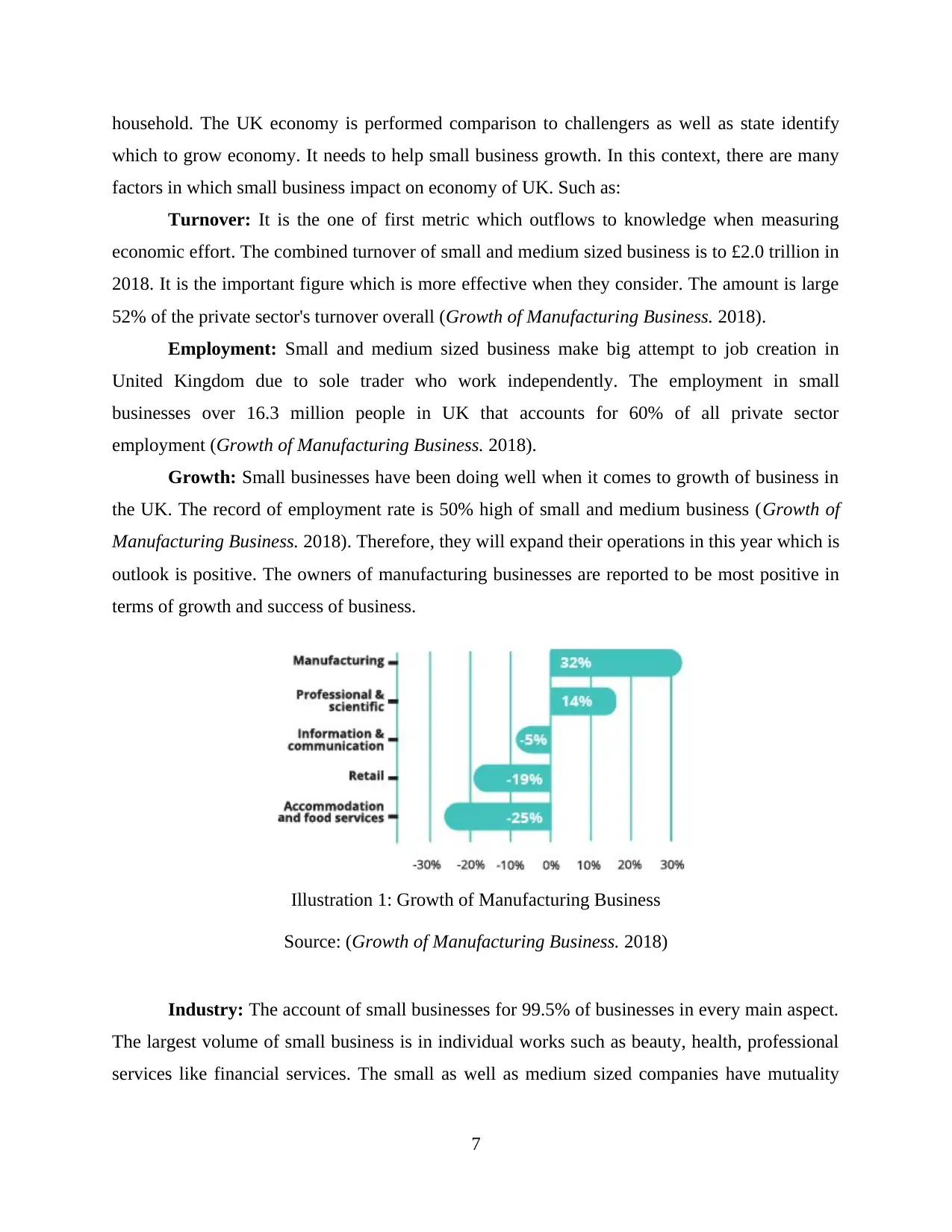
household. The UK economy is performed comparison to challengers as well as state identify
which to grow economy. It needs to help small business growth. In this context, there are many
factors in which small business impact on economy of UK. Such as:
Turnover: It is the one of first metric which outflows to knowledge when measuring
economic effort. The combined turnover of small and medium sized business is to £2.0 trillion in
2018. It is the important figure which is more effective when they consider. The amount is large
52% of the private sector's turnover overall (Growth of Manufacturing Business. 2018).
Employment: Small and medium sized business make big attempt to job creation in
United Kingdom due to sole trader who work independently. The employment in small
businesses over 16.3 million people in UK that accounts for 60% of all private sector
employment (Growth of Manufacturing Business. 2018).
Growth: Small businesses have been doing well when it comes to growth of business in
the UK. The record of employment rate is 50% high of small and medium business (Growth of
Manufacturing Business. 2018). Therefore, they will expand their operations in this year which is
outlook is positive. The owners of manufacturing businesses are reported to be most positive in
terms of growth and success of business.
Industry: The account of small businesses for 99.5% of businesses in every main aspect.
The largest volume of small business is in individual works such as beauty, health, professional
services like financial services. The small as well as medium sized companies have mutuality
7
Illustration 1: Growth of Manufacturing Business
Source: (Growth of Manufacturing Business. 2018)
which to grow economy. It needs to help small business growth. In this context, there are many
factors in which small business impact on economy of UK. Such as:
Turnover: It is the one of first metric which outflows to knowledge when measuring
economic effort. The combined turnover of small and medium sized business is to £2.0 trillion in
2018. It is the important figure which is more effective when they consider. The amount is large
52% of the private sector's turnover overall (Growth of Manufacturing Business. 2018).
Employment: Small and medium sized business make big attempt to job creation in
United Kingdom due to sole trader who work independently. The employment in small
businesses over 16.3 million people in UK that accounts for 60% of all private sector
employment (Growth of Manufacturing Business. 2018).
Growth: Small businesses have been doing well when it comes to growth of business in
the UK. The record of employment rate is 50% high of small and medium business (Growth of
Manufacturing Business. 2018). Therefore, they will expand their operations in this year which is
outlook is positive. The owners of manufacturing businesses are reported to be most positive in
terms of growth and success of business.
Industry: The account of small businesses for 99.5% of businesses in every main aspect.
The largest volume of small business is in individual works such as beauty, health, professional
services like financial services. The small as well as medium sized companies have mutuality
7
Illustration 1: Growth of Manufacturing Business
Source: (Growth of Manufacturing Business. 2018)
Paraphrase This Document
Need a fresh take? Get an instant paraphrase of this document with our AI Paraphraser
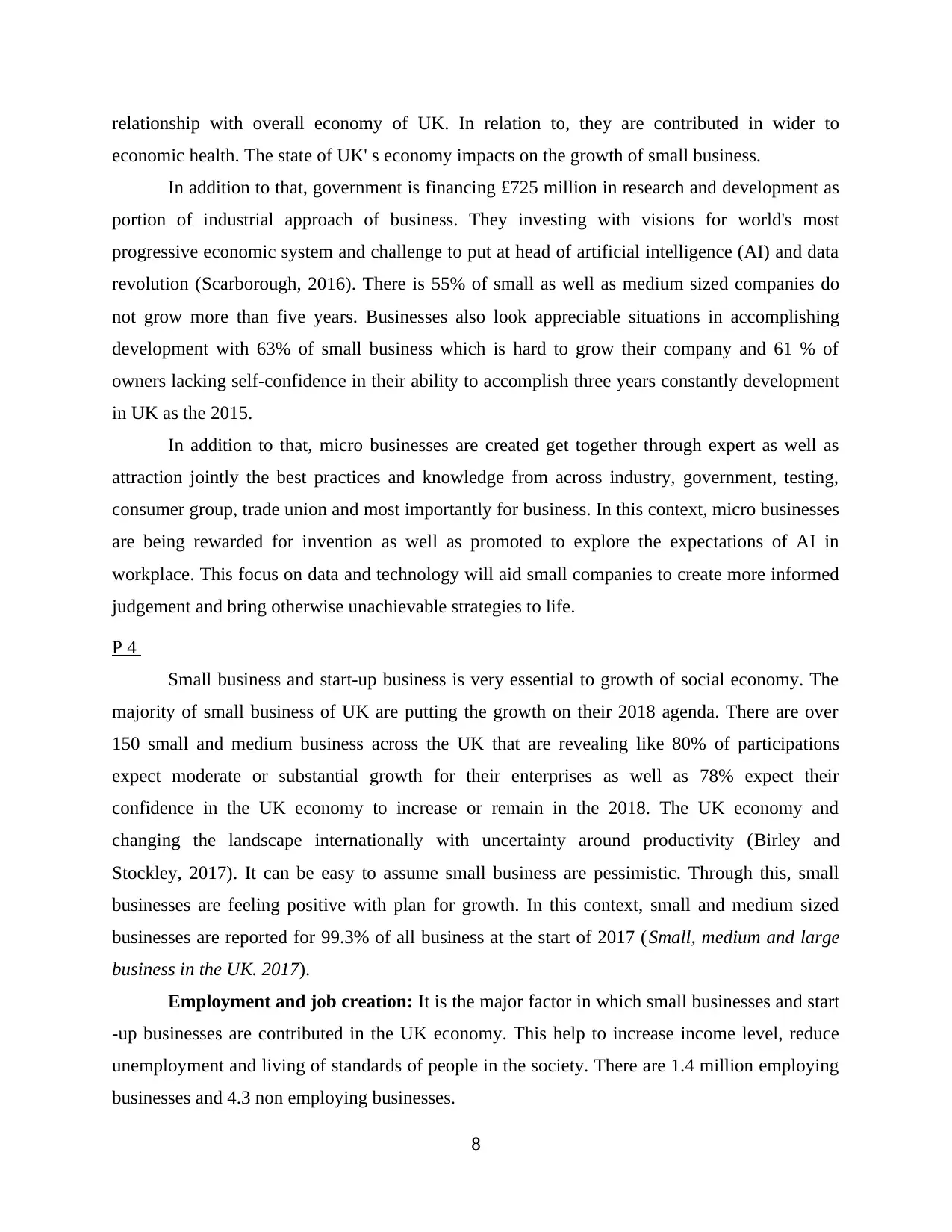
relationship with overall economy of UK. In relation to, they are contributed in wider to
economic health. The state of UK' s economy impacts on the growth of small business.
In addition to that, government is financing £725 million in research and development as
portion of industrial approach of business. They investing with visions for world's most
progressive economic system and challenge to put at head of artificial intelligence (AI) and data
revolution (Scarborough, 2016). There is 55% of small as well as medium sized companies do
not grow more than five years. Businesses also look appreciable situations in accomplishing
development with 63% of small business which is hard to grow their company and 61 % of
owners lacking self-confidence in their ability to accomplish three years constantly development
in UK as the 2015.
In addition to that, micro businesses are created get together through expert as well as
attraction jointly the best practices and knowledge from across industry, government, testing,
consumer group, trade union and most importantly for business. In this context, micro businesses
are being rewarded for invention as well as promoted to explore the expectations of AI in
workplace. This focus on data and technology will aid small companies to create more informed
judgement and bring otherwise unachievable strategies to life.
P 4
Small business and start-up business is very essential to growth of social economy. The
majority of small business of UK are putting the growth on their 2018 agenda. There are over
150 small and medium business across the UK that are revealing like 80% of participations
expect moderate or substantial growth for their enterprises as well as 78% expect their
confidence in the UK economy to increase or remain in the 2018. The UK economy and
changing the landscape internationally with uncertainty around productivity (Birley and
Stockley, 2017). It can be easy to assume small business are pessimistic. Through this, small
businesses are feeling positive with plan for growth. In this context, small and medium sized
businesses are reported for 99.3% of all business at the start of 2017 (Small, medium and large
business in the UK. 2017).
Employment and job creation: It is the major factor in which small businesses and start
-up businesses are contributed in the UK economy. This help to increase income level, reduce
unemployment and living of standards of people in the society. There are 1.4 million employing
businesses and 4.3 non employing businesses.
8
economic health. The state of UK' s economy impacts on the growth of small business.
In addition to that, government is financing £725 million in research and development as
portion of industrial approach of business. They investing with visions for world's most
progressive economic system and challenge to put at head of artificial intelligence (AI) and data
revolution (Scarborough, 2016). There is 55% of small as well as medium sized companies do
not grow more than five years. Businesses also look appreciable situations in accomplishing
development with 63% of small business which is hard to grow their company and 61 % of
owners lacking self-confidence in their ability to accomplish three years constantly development
in UK as the 2015.
In addition to that, micro businesses are created get together through expert as well as
attraction jointly the best practices and knowledge from across industry, government, testing,
consumer group, trade union and most importantly for business. In this context, micro businesses
are being rewarded for invention as well as promoted to explore the expectations of AI in
workplace. This focus on data and technology will aid small companies to create more informed
judgement and bring otherwise unachievable strategies to life.
P 4
Small business and start-up business is very essential to growth of social economy. The
majority of small business of UK are putting the growth on their 2018 agenda. There are over
150 small and medium business across the UK that are revealing like 80% of participations
expect moderate or substantial growth for their enterprises as well as 78% expect their
confidence in the UK economy to increase or remain in the 2018. The UK economy and
changing the landscape internationally with uncertainty around productivity (Birley and
Stockley, 2017). It can be easy to assume small business are pessimistic. Through this, small
businesses are feeling positive with plan for growth. In this context, small and medium sized
businesses are reported for 99.3% of all business at the start of 2017 (Small, medium and large
business in the UK. 2017).
Employment and job creation: It is the major factor in which small businesses and start
-up businesses are contributed in the UK economy. This help to increase income level, reduce
unemployment and living of standards of people in the society. There are 1.4 million employing
businesses and 4.3 non employing businesses.
8
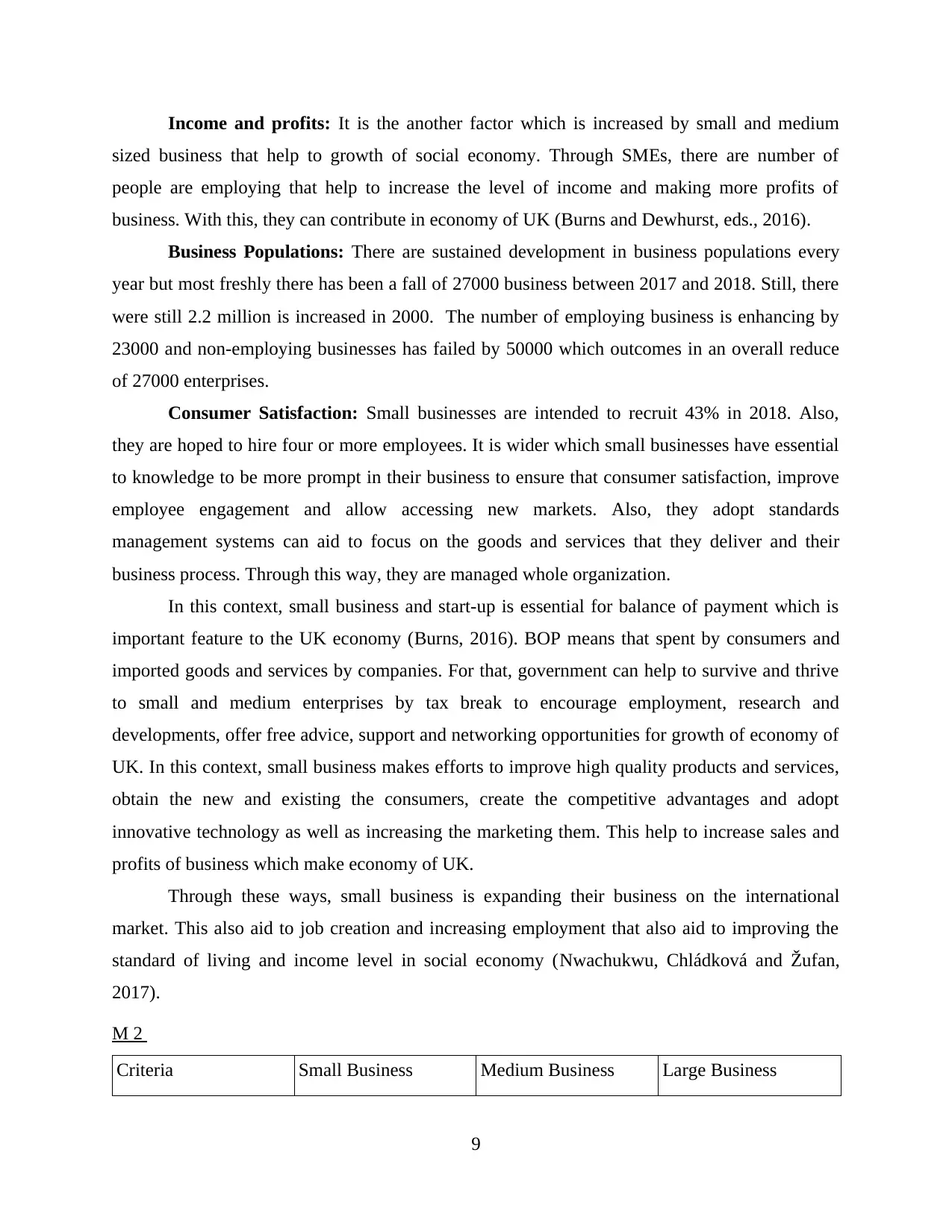
Income and profits: It is the another factor which is increased by small and medium
sized business that help to growth of social economy. Through SMEs, there are number of
people are employing that help to increase the level of income and making more profits of
business. With this, they can contribute in economy of UK (Burns and Dewhurst, eds., 2016).
Business Populations: There are sustained development in business populations every
year but most freshly there has been a fall of 27000 business between 2017 and 2018. Still, there
were still 2.2 million is increased in 2000. The number of employing business is enhancing by
23000 and non-employing businesses has failed by 50000 which outcomes in an overall reduce
of 27000 enterprises.
Consumer Satisfaction: Small businesses are intended to recruit 43% in 2018. Also,
they are hoped to hire four or more employees. It is wider which small businesses have essential
to knowledge to be more prompt in their business to ensure that consumer satisfaction, improve
employee engagement and allow accessing new markets. Also, they adopt standards
management systems can aid to focus on the goods and services that they deliver and their
business process. Through this way, they are managed whole organization.
In this context, small business and start-up is essential for balance of payment which is
important feature to the UK economy (Burns, 2016). BOP means that spent by consumers and
imported goods and services by companies. For that, government can help to survive and thrive
to small and medium enterprises by tax break to encourage employment, research and
developments, offer free advice, support and networking opportunities for growth of economy of
UK. In this context, small business makes efforts to improve high quality products and services,
obtain the new and existing the consumers, create the competitive advantages and adopt
innovative technology as well as increasing the marketing them. This help to increase sales and
profits of business which make economy of UK.
Through these ways, small business is expanding their business on the international
market. This also aid to job creation and increasing employment that also aid to improving the
standard of living and income level in social economy (Nwachukwu, Chládková and Žufan,
2017).
M 2
Criteria Small Business Medium Business Large Business
9
sized business that help to growth of social economy. Through SMEs, there are number of
people are employing that help to increase the level of income and making more profits of
business. With this, they can contribute in economy of UK (Burns and Dewhurst, eds., 2016).
Business Populations: There are sustained development in business populations every
year but most freshly there has been a fall of 27000 business between 2017 and 2018. Still, there
were still 2.2 million is increased in 2000. The number of employing business is enhancing by
23000 and non-employing businesses has failed by 50000 which outcomes in an overall reduce
of 27000 enterprises.
Consumer Satisfaction: Small businesses are intended to recruit 43% in 2018. Also,
they are hoped to hire four or more employees. It is wider which small businesses have essential
to knowledge to be more prompt in their business to ensure that consumer satisfaction, improve
employee engagement and allow accessing new markets. Also, they adopt standards
management systems can aid to focus on the goods and services that they deliver and their
business process. Through this way, they are managed whole organization.
In this context, small business and start-up is essential for balance of payment which is
important feature to the UK economy (Burns, 2016). BOP means that spent by consumers and
imported goods and services by companies. For that, government can help to survive and thrive
to small and medium enterprises by tax break to encourage employment, research and
developments, offer free advice, support and networking opportunities for growth of economy of
UK. In this context, small business makes efforts to improve high quality products and services,
obtain the new and existing the consumers, create the competitive advantages and adopt
innovative technology as well as increasing the marketing them. This help to increase sales and
profits of business which make economy of UK.
Through these ways, small business is expanding their business on the international
market. This also aid to job creation and increasing employment that also aid to improving the
standard of living and income level in social economy (Nwachukwu, Chládková and Žufan,
2017).
M 2
Criteria Small Business Medium Business Large Business
9
⊘ This is a preview!⊘
Do you want full access?
Subscribe today to unlock all pages.

Trusted by 1+ million students worldwide
1 out of 17
Related Documents
Your All-in-One AI-Powered Toolkit for Academic Success.
+13062052269
info@desklib.com
Available 24*7 on WhatsApp / Email
![[object Object]](/_next/static/media/star-bottom.7253800d.svg)
Unlock your academic potential
Copyright © 2020–2025 A2Z Services. All Rights Reserved. Developed and managed by ZUCOL.





